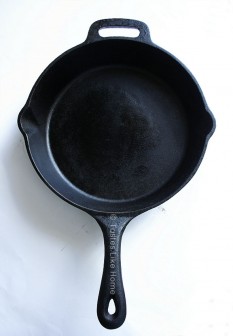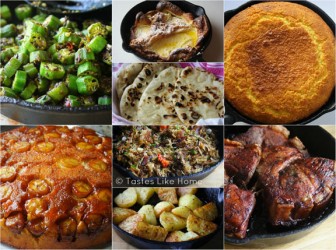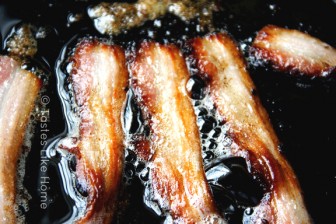Hi Everyone,
It is excellent for baking, roasting, toasting, frying, searing and sautéing. It can go from the stovetop to the oven. It can go from the oven to the table. It can be used for indoor and outdoor cooking. It lasts a lifetime. It can be handed down from one generation to the next, that’s how sturdy and durable it is. What is it? A cast iron skillet.
I almost never recommend that people buy specific tools and equipment because you can cook with whatever you currently have in your kitchen. I make an exception in this case because this is one piece of kitchen equipment, which, like I said, will last you a lifetime and can be used for a variety of cooking methods. Don’t get me wrong, it is not that you MUST have a cast iron skillet, but if you’ve been thinking about getting one, don’t hesitate, you won’t regret it. Hold a sec though, before you rush out of the house to the kitchen store or wherever you buy your cookware, call up some relatives and friends of the older generation and see if they still have theirs. If they do, then you’re in business. All you’ll need to do is clean it up.
Cast iron cookware has been around for centuries and then it went out of style as other metals became popular, easier to market and certainly more attractive to the eye. As such, many people gave away, discarded or simply abandoned their cast iron pans to some remote corner of their cupboards. Although top brands such as Le Creuset enhanced the image of cast iron with the outer and inner coatings of enamel, the everyday cast iron skillet devoid of any sort of overlay was shunned. Abandoned. Left to rust in some corner.

Aptly described as the best pan in your kitchen, this versatile piece of equipment is an even conductor of heat enabling your food to cook evenly and quickly. You can roast a chicken, bake pork chops, cook a steak, make a sauce, fry fish and chicken, sauté vegetables, scramble eggs, bake a pie, roast potatoes, make pancakes, toast bread and even cook roti using a cast iron skillet. That’s how exceptional this single pan is. My favourite way to use my cast iron skillet is to start by cooking something on the stovetop and finish the cooking process in the oven without changing pans. When the food is done, I can opt to take it straight to the table working it (the pan) as a serving vessel.

There are two things you have to concern yourself about with a cast iron skillet – seasoning it and cleaning it.
Seasoning & Washing
To season a cast iron pan is to give it a protective coating of some sort of grease to prevent it from rusting. The seasoning is something you can do once a year, however, if you are using your pan regularly, washing and maintaining it properly, you don’t have to worry much about yearly seasoning.
There are different methods of seasoning a cast iron skillet; these days most skillets are also sold pre-seasoned. In other words, when you buy the pan, you will notice that it looks a little greasy, that is because it is already seasoned. If your skillet was bought already seasoned, when you get home wash it in some hot soapy water with a soft to medium brush, not a pot-scrubber and especially not a metal pot scrubber. Once properly rinsed, dry it thoroughly and rub a light coating of oil all over the pan – inside and out.
You can further this stage of protection by placing your skillet in an oven that has a pilot light and leaving it there for a few hours. Or place the pan in the oven, turn on the oven to a low heat – about 140 degrees F for about 2 hours, shut off the heat and leave the pan in there until cooled.
Alternately, after washing and drying the pan, you can cook some bacon in the pan. I find this to be the easiest (not to mention delicious), and a very effective way to season the pan. When the bacon is done cooking, remove it from the pan and leave the grease in the pan overnight, the next day, rinse the pan with hot water (no soap) and wipe it dry.
The more often you cook with your cast iron skillet, the more seasoned it will become. The better it will perform.

To clean your pan, remember don’t scrub it with anything harsh. Hot water and a brush is all you need and if necessary some times, a little soap but no abrasive washing agents. I cannot overemphasize the importance of drying the pan immediately after it is washed.
Now, if you get a pan that family or friends have managed to locate that they have not used in ages, then you have some work to do. It’s highly likely that there would be rust. If you’ve found one and want to spend the time cleaning it, here’s what to do. Get yourself a can or two of heavy-duty oven cleaner and have a go at it. Follow the instructions on the can that indicates to spray, leave for a period of time and then clean. You may have to do this more than 2 times depending on how bad shape the skillet is in.
Once you’ve removed the rust and build-up, wash with hot soapy water, dry and fry some bacon and start cooking with your cast iron skillet!






